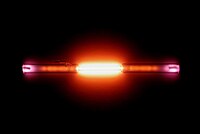
Photo from wikipedia
This paper describes the multiresponse optimization of tungsten inert gas welding for an optimal parametric combination to predict the weld characteristics of thin cold rolled steel sheets. The interaction effects… Click to show full abstract
This paper describes the multiresponse optimization of tungsten inert gas welding for an optimal parametric combination to predict the weld characteristics of thin cold rolled steel sheets. The interaction effects of tungsten inert gas welding process parameters such as welding current, arc length, and traverse speed have been observed on the weld characteristic responses such as weld width, heat-affected zone width, and under-bead depression. Full factorial design of experiment was followed for determining the combinations of the experimental runs. Regression analysis was carried out to develop the mathematical models for the welding control factors and responses. Analysis of variance was used to check the adequacy of the developed mathematical model. The confirmatory tests were conducted to validate the accuracy of mathematical model. Sensitivity analysis was also done to analyze the effect of each individual process parameter on the weld responses. The full factorial experimental data was further utilized for multi-response optimization of the tungsten inert gas process parameters. It was observed that weld responses like weld width and heat-affected zone width could be optimized by regression modeling technique while the under-bead depression showed uncertain behavior. The under-bead depression ranged from 0.0 to 0.15 mm and was observed only when the arc traverse speed was at the lowest level (4 cm/min) for all values of the welding current and arc length. The experimental data were also modeled using the artificial neural network technique for the prediction of weld responses and the results were compared with that from the regression analysis.
Journal Title: Proceedings of the Institution of Mechanical Engineers, Part E: Journal of Process Mechanical Engineering
Year Published: 2018
Link to full text (if available)
Share on Social Media: Sign Up to like & get
recommendations!